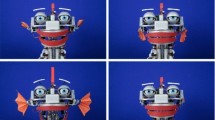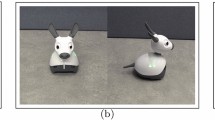Abstract
In this paper, we investigate the relationship between emotions and colors by showing robot animated emotion faces and colors to the participants through a series of surveys. We focused on representing a visualized emotion through a robot's facial expression and background colors. To complete the emotion design with animated faces and color background, we gave an experimental design for surveying the users' thoughts. We took an example of a robot animated face by using the ASUS Zenbo. We selected 11 colors as our color background and 24 facial expressions from Zenbo. To analyze our results from questionnaires, we used histograms to show the basic data situation and the multiple logistic regression analysis (MLRA) to see the marginal relationships. We separated our questionnaires into positive and negative questionnaires and divided the dataset into three cases to discuss the different relationships between color and emotion. Results showed that people preferred the blue color no matter whether the face was showing positive or negative emotion. The MLRA also showed the correct percentage is outstanding in case 2, either positive emotion or negative emotion. Participants thought Zenbo's robotic animated face was the same as they thought. Through our experimental design, we hope that people can consider more colors with emotion to design the human–robot interface that will be closer to the users' thoughts and make life more colorful with comfortable reactions with robots.





Similar content being viewed by others
References
Mori M, MacDorman KF, Kageki N (2012) The uncanny valley. Robot Autom Mag IEEE 19(2):98–100
Herse S, Vitale J, Tonkin M, Ebrahimian D, Ojha S, Johnston B, Judge W, and Williams M (2018). Do you trust me, blindly? Factors influencing trust to-wards a robot recommender system, 2018 27th IEEE International Symposium on Robot and Human Interactive Communication (RO-MAN), Nanjing, China, 7–14.
Kanda T, Ishiguro H, Imai M, Ono T (2004) Development and evaluation of interactive humanoid robots. Proc IEEE 92(11):1839–1850
Bartneck C, Belpaeme T, Eyssel F, Kanda T, Keijsers M, Sabanovic S (2020) Human-robot interaction – an introduction. Cambridge University Press, Cambridge
Lin P-C, Mettrick D, Hung PCK, and Iqbal F (2018). Towards a music visualization on robot (MVR) prototype, IEEE International Conference on Artificial Intelligence and Virtual Reality (AIVR2018), 256–257, Taichung, Taiwan, December 10–12
Lin P-C, Mettrick D, Hung PCK, Iqbal F (2019) Robot computing for music visualization, theory and applications of models of computation. TAMC 2019. Lect Notes Comput Sci 11436:438–447
Lin, P-C, Hung PCK (2021) A case study of facial expression and color for social robot’s emotion expression, The 23rd International conference on artificial intelligence, (ICAI'21) in the 2021 World Congress in Computer Science, Computer Engineering, & Applied Computing (CSCE'21), Virtual and live at Luxor (MGM), Las Vegas, USA, July 26–29
Schütte STW, Eklund J, Axelsson JRC, Nagamachi M (2004) Concepts, methods and tools in Kansei engineering. Theor Issues Ergon Sci Taylor Francis 5(3):214–231
Park C, Ryu J, Sohn J, and Cho H (2007) An Emotion Expression System for the Emotional Robot, 2007 IEEE International Symposium on Consumer Electronics, Irving, Texas, USA, 1–6
Kwon D et al. (2007). Emotion Interaction System for a Service Robot, the 16th IEEE International Symposium on Robot and Human Interactive Communication (RO-MAN 2007), Jeju, Korea, 351–356
Takeno J, Mori K, Naito Y (2009) A robot with complex facial expressions. Sens Transducers Spec Issue 6:18–26
Saldien J, Goris K, Vanderborght B, Vanderfaeillie J, Lefeber D (2010) Expressing emotions with the social robot probo. Int J Soc Robot 2(4):377–389
Cohen I, Looije R, and Neerincx MA (2011) Child's recognition of emotions in robot's face and body, the 6th ACM/IEEE International Conference on Human-Robot Interaction (HRI), Lausanne, 123–124
Read R and Belpaeme T (2012) How to use non-linguistic utterances to convey emotion in child-robot interaction, the 7th ACM/IEEE International Conference on Human-Robot Interaction (HRI), Boston, MA, USA, 219–220
Kędzierski J, Muszyński R, Zoll C, Oleksy A, Frontkiewicz M (2013) EMYS—Emotive head of a social robot. Int J Soc Robot 5(2):237–249
Mirnig N, Strasser E, Weiss A, Kühnlenz B, Wollherr D, Tscheligi M (2014) Can you read my face?: a methodological variation for assessing facial expressions of robotic heads. Int J Soc Robot 7(1):63–76
Ali F, Jun GW (2015). Design of robot head for expression of human emotion. applied mechanics and materials, 773–774, 893–897. Shih W, Naruse K, and Wu S (2017). Implement human-robot interaction via robot's emotion model, the IEEE 8th International Conference on Awareness Science and Technology (iCAST), Taichung, Taiwan, 580–585
Shih W, Naruse K, Wu S (2017) Implement human-robot interaction via robot's emotion model, the IEEE 8th International Conference on Awareness Science and Technology (iCAST), Taichung, Taiwan, 580–585
Reuten A, van Dam M, Naber M (2018) Pupillary responses to robotic and human emotions: the uncanny valley and media equation confirmed. Front Psychol 9:774–774
Chew E, Chua XN (2020) Robotic Chinese language tutor: personalising progress assessment and feedback or taking over your job? Horizon 28(3):113–124
Kita S, Mita A (2015) Emotion identification method using RGB information of human face, In: Proceedings of SPIE—The International Society for Optical Engineering, vol 9435, p 6
Tielman M, Neerincx M, Meyer JJ, Looije R (2014) Adaptive emotional expression in robot-child interaction, In: the ACM/IEEE International Conference on Human-Robot Interaction, p 407–414
Arora P Chaspari T (2018) Exploring Siamese neural network architectures for preserving speaker identity in speech emotion classification, In: Proceedings of the 4th Workshop on Multimodal Analyses Enabling Artificial Agents in Human-Machine Interaction, MA3HMI 2018 - In conjunction with ICMI 2018, p 15–18
Latif S, Khalifa S, Rana R, Jurdak R (2020) Federated learning for speech emotion recognition applications, In: Proceedings - 2020 19th ACM/IEEE International Conference on Information Processing in Sensor Networks, IPSN 2020, art. no. 9111050, p 341–342
Hsieh WF, Sato-Shimokawara E, Yamaguchi T (2020) Investigation of robot expression style in human-robot interaction. J Robot Mechatron 32(1):224–235
Chuah SHW, Yu J (2021) The future of service: the power of emotion in human-robot interaction. J Retail Consum Serv 61:102551
Kaya N, Epps HH (2004) Relationship between color and emotion: a study of college students. Coll Stud J 38(3):396–405
Hanada. (2018) Correspondence analysis of color–emotion associations. Color Res Appl 43(2):224–237
Demir. (2020) Investigation of color-emotion associations of the university students. Color Res Appl 45(5):871–884
Takei A, Imaizumi S (2022) Effects of color–emotion association on facial expression judgments. Heliyon 8(1):e08804–e08804
Terada K, Yamauchi A, Ito A (2012). Artificial emotion expression for a robot by dynamic color change. 2012 IEEE RO-MAN: The 21st IEEE International Symposium on Robot and Human Interactive Communication, 314–321
Li J, Chen L, Pan D, Wang F, Yang Y (2019) Red or blue? Effects of background color in distraction tasks on global processing in unconscious thought. Curr Psychol (New Brunswick, NJ) 40(5):2153–2160
Wang T, Shu S, Mo L (2014) Blue or red? The effects of colour on the emotions of Chinese people. Asian J Soc Psychol 17(2):152–158
Bekhtereva V, Müller MM (2017) Bringing color to emotion: the influence of color on attentional bias to briefly presented emotional images. Cognit Affect Behav Neurosci 17(5):1028–1047
Wilms, & Oberfeld, D. (2017) Color and emotion: effects of hue, saturation, and brightness. Psychol Res 82(5):896–914
Wan J, Zhou Y, Li Y, Su Y, Cao Y, Zhang L, Ying L, Deng W (2020) Research on color space perceptions and restorative effects of blue space based on color psychology: examination of the Yijie District of Dujiangyan City as an Example. Int J Environ Res Public Health 17(9):3137
Johnson DO, Cuijpers RH, van der Pol D (2013) Imitating human emotions with artificial facial expressions. Int J Soc Robot 5(4):503–513
Sixseconds (2020). Plutchik's wheel of emotions: exploring the emotion wheel. Online: https://www.6seconds.org/2017/04/27/plutchiks-model-of-emotions/
Birren F (2013) Color Psychology and color therapy: a factual study of the influence of color on human life. Martino Fine Books, USA
Madden TJ, Hewett K, Roth MS (2000) Managing images in different cultures: a cross-national study of color meanings and preferences. J Int Market (East Lansing, Mich) 8(4):90–107
Affects C (2008) Psychological properties of colours. Online: http://www.colour-affects.co.uk/psychological-properties-of-colours
Nezlek JB, Kuppens P (2008) Regulating positive and negative emotions in daily. Life, J Person 76(3):561–580
Acknowledgements
This research was supported by the Ministry of Education, R.O.C., under the grant TEEP@AsiaPlus. The work in this paper was also supported by the Ministry of Science and Technology under Grant No. MOST 109-2221-E-035-063-MY2. The data that support the findings of this study are not openly available due to the research topic still continuous with a MOST funding project and are available from the corresponding author P.-C. Lin upon reasonable request. The authors declare that there is no conflict of interest.
Author information
Authors and Affiliations
Corresponding author
Additional information
Publisher's Note
Springer Nature remains neutral with regard to jurisdictional claims in published maps and institutional affiliations.
Rights and permissions
Springer Nature or its licensor holds exclusive rights to this article under a publishing agreement with the author(s) or other rightsholder(s); author self-archiving of the accepted manuscript version of this article is solely governed by the terms of such publishing agreement and applicable law.
About this article
Cite this article
Lin, PC., Hung, P.C.K., Jiang, Y. et al. An experimental design for facial and color emotion expression of a social robot. J Supercomput 79, 1980–2009 (2023). https://doi.org/10.1007/s11227-022-04734-7
Accepted:
Published:
Issue Date:
DOI: https://doi.org/10.1007/s11227-022-04734-7




